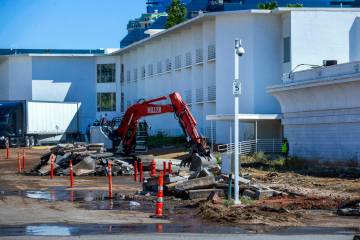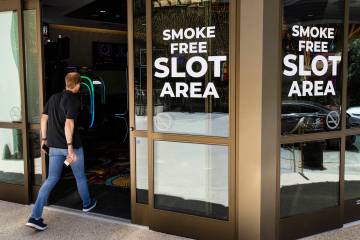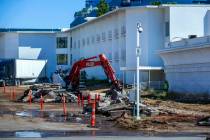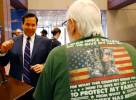Nevada unemployment grows in July
If you're waiting for an end to Nevada's 16-month string of record unemployment, well, hunker down and dig in.
Experts say it'll be at least half a year before the hiring picture stabilizes, and the Silver State could easily see jobless gains through the end of 2010.
"It really comes back to consumers," said Jered McDonald, an economist with the state Department of Employment, Training and Rehabilitation. "As long as consumers worry about maintaining a job and taking pay cuts, they're just not going to spend on a trip to Las Vegas, and until those folks can start coming back in greater numbers, we're probably going to remain on a negative economic trend."
The employment department reported Friday that joblessness in Nevada hit a record 14.3 percent in July, up from 14.2 percent in June and 12.3 percent in July 2009. In Las Vegas, the rate jumped to 14.8 percent, compared with 14.6 percent in June and 13 percent in July 2009. Nearly 200,000 Nevadans lack jobs and are seeking work, including 144,500 Las Vegans.
Throw in discouraged workers who've left the labor force and underemployed workers who can't find full-time jobs, and Nevada's jobless rate exceeded 21 percent through June 30, according to the latest data from the U.S. Bureau of Labor Statistics. Nevada ranked No. 1 in the country for joblessness in June, while Las Vegas took the top spot among cities of 1 million or more in the month. State officials said they expect the state and city to keep those top positions once all July numbers come in.
What's more, some important labor bellwethers have reversed their favorable trends of past months, noted Jeremy Aguero, a principal in local research firm Applied Analysis.
After some recent declines, the state's labor force grew again from June to July, adding 1,300 people to its 1.4 million-worker base. That suggests some residents are returning to the market to seek work, which can put upward pressure on jobless figures. Hotel-casinos pared 400 positions from June to July, after adding jobs month-over-month earlier in 2010. And the state's private-sector jobs base shrank for the first time since March, with 4,000 positions cut from June to July.
Future trends won't likely bring much near-term relief: Aguero said he foresees continued instability in construction, as developments under way wrap up, and government deficits could yield additional public-sector layoffs into the fall and winter.
"We expect unemployment to largely stay well above 14 percent, if not continue to rise somewhat," Aguero said. "For the balance of 2010, I think the best we can really hope for is stability."
The fortunes of one industry in particular portend sluggish hiring through the end of the year.
The employment-services and placement field slashed 800 jobs statewide in July. Those cuts mean hard times for the businesses that supply temporary workers to expanding companies. Businesses typically increase temporary hiring before they start adding permanent staff, so until employment agencies begin growing, Nevada won't likely see big gains in full-time jobs, McDonald said.
Aguero noted that his company's analysis shows no substantial uptick in the number of hours worked per employee, which also hints that local companies aren't ready to expand their labor pools.
That's not to say the latest jobs report was all bad. Construction didn't lose any jobs in Las Vegas from June to July. The combined category of trade, transportation and utilities, a sector that includes retailers, grew locally by 600 jobs month over month. Statewide, mining employment expanded.
Plus, other important indicators have stabilized or even improved, Aguero noted, and those trends could mean fewer job losses later. The Las Vegas Convention and Visitors Authority has reported a string of increases in tourist volume through virtually all of 2010, and average daily hotel-room rates and occupancy levels have markedly improved when compared with 2009 levels. Taxable sales no longer decline by double digits every month, and now turn in much smaller year-over-year declines and even the occasional increase.
"We're approaching something that looks like the bottom, but the question is, is that bottom sustainable, and if so, what are the future sources of growth? I think everyone's mind is on that," Aguero said.
Whether Nevada can sustain its economic plateau depends in large part on the national economy. And the news there turned south on Friday, when new reports showed that first-time jobless claims surpassed economists' expectations and surged to a nine-month high last week. The jump in claims renewed talk of a double-dip recession, with analysts and experts taking to the airwaves to discuss the potential for a fresh downturn following several months of growth in the nation's gross domestic product.
Aguero pegged the odds of a national double-dip recession at a "relatively substantial" 33 percent, and said such a trend would only deepen and extend Southern Nevada's slump.
"The right adjective to use for the state and national economy is 'fragile,' " Aguero said. "Every day we're getting news. Sometimes that news is good, and sometimes it's bad. Consumers are reacting oddly and immediately to that information in ways we haven't seen before. The economy overall is showing signs of improvement, but that improvement has proven to be somewhat unsustainable."
Bill Lerner, an analyst with Union Gaming Group in Las Vegas, wrote in a note to investors that the Las Vegas economy continues to struggle with consumers' eroding buying power, as reduced working hours, declining tip income and skimpier benefits eat away at discretionary income. Other factors, such as increases in the inventory of homes for sale, will also affect the city's economy, Lerner wrote.
The state employment department already forecasts higher unemployment through the end of 2010, but the department would have to revise its projections upward should the United States slump back into recession, McDonald said.
Still, McDonald said job growth should pick up in the second half of 2011, though the state's unemployment rate will decline slowly in the next few years.
Contact reporter Jennifer Robison at jrobison@review journal.com or 702-380-4512.





























